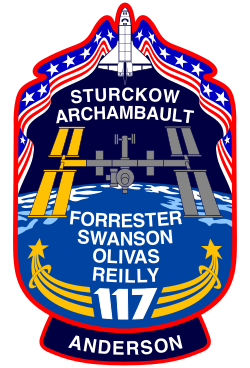Frederick Wilford Sturckow
| Frederick Wilford Sturckow | |
|---|---|
 Frederick Wilford Sturckow | |
| Astronaut NASA | |
| Státní příslušnost | |
| Datum narození | 11. srpna 1961 (61 let) |
| Místo narození | La Mesa, Kalifornie, USA |
| Předchozí zaměstnání | pilot |
| Hodnost | major |
| Čas ve vesmíru | 51 dní, 9 hodin a 36 minut |
| Kosmonaut od | 1994 |
| Mise | STS-88, STS-105, STS-117, STS-128 |
| Znaky misí | |
| Některá data mohou pocházet z datové položky. | |
Frederick Wilford Sturckow (* 11. srpna 1961 La Mesa, Kalifornie, USA) je americký důstojník vojenského námořnictva a kosmonaut. Ve vesmíru byl čtyřikrát.
Život
Studium a zaměstnání
Absolvoval střední školu Grossmont High School, po skončení studia v roce 1978 vysokoškolské vzdělání získal studiem na California Polytechnic State University. Studium zde ukončil v roce 1984.
V letech 1984 až 1994 sloužil na různých místech světa jako americký vojenský pilot. Oženil se, jeho manželkou je Michele, rozená Streetová.
Má přezdívky CJ a Rick.
Zaškolení budoucích kosmonautů v Houstonu absolvoval v letech 1994 – 1995, poté byl zařazen do tamní jednotky kosmonautů NASA.
Lety do vesmíru
Na oběžnou dráhu se v raketoplánu dostal čtyřikrát, pracoval na orbitální stanici ISS, strávil ve vesmíru 51 dní, 9 hodin a 36 minut. Byl 384 člověkem ve vesmíru.
- STS-88 Endeavour (4. prosince 1998 – 13. prosince 1998), pilot
- STS-105 Discovery (10. srpen 2001 – 22. srpen 2001), pilot
- STS-117 Atlantis (8. června 2007 – 22. června 2007), velitel
- STS-128 Discovery (29. srpen 2009 – 12. září 2009), velitel
Odkazy
Externí odkazy
 Obrázky, zvuky či videa k tématu Frederick Wilford Sturckow na Wikimedia Commons
Obrázky, zvuky či videa k tématu Frederick Wilford Sturckow na Wikimedia Commons - Na webu Space
- Na webu MEK-Kosmo
Média použitá na této stránce
Designed by the crew members, this patch commemorates the first assembly flight to carry United States-built hardware for constructing the International Space Station (ISS). This flight's primary task is to assemble the cornerstone of the Space Station: the Node with the Functional Cargo Block (fgb).
The rising sun symbolizes the dawning of a new era of international cooperation in space and the beginning of a new program: the International Space Station. The Earth scene outlines the countries of the Station Partners: the United States, Russia, those of the European Space Agency (ESA), Japan, and Canada. Along with the Pressurized Mating Adapters (PMA) and the Functional Cargo Block, the Node is shown in the final mated configuration while berthed to the Space Shuttle during the STS-88/2A mission.
The STS-105 crew patch symbolizes the exchange of the Expedition Two and Expedition Three crews aboard the International Space Station. The three gold stars near the ascending Orbiter represent the U.S. commanded Expedition Three crew as they journey into space, while the two gold stars near the descending Orbiter represent the Russian commanded Expedition Two crew and their return to Earth. The plumes of each Orbiter represent the flags of the United States and Russia and symbolize the close cooperation between the two countries. The Astronaut Office symbol, a star with three rays of light, depicts the unbroken link between Earth and the newest and brightest star on the horizon, the International Space Station (ISS). The ascending and descending Orbiters form a circle that represents both the crew rotation and the continuous presence in space aboard the ISS. The names of the four astronauts who will crew Discovery are shown along the border of the patch. The names of the Expedition Three and Expedition Two crews are shown on the chevron at the bottom of the patch. The NASA insignia design for Shuttle flights is reserved for use by the astronauts and for other official use as the NASA Administrator may authorize. Public availability has been approved only in the form of illustrations by the various news media. When and if there is any change in this policy, which we do not anticipate, it will be publicly announced.
The STS-117 crew patch symbolizes the continued construction of the International Space Station (ISS) and our ongoing human presence in space. The ISS is shown orbiting high above the Earth. Gold is used to highlight the portion of the ISS that will be installed by the STS-117 crew. It consists of the second starboard truss section, S3/S4, and a set of solar arrays. The names of the STS-117 crew are located above and below the orbiting outpost. The two gold astronaut office symbols, emanating from the '117' at the bottom of the patch represent the concerted efforts of the shuttle and station programs toward the completion of the station. The orbiter and unfurled banner of red, white and blue represent our Nation's renewed patriotism as we continue to explore the universe.
The STS-128 patch symbolizes the 17A mission and represents the hardware, people and partner nations that contribute to the flight. The Space Shuttle Discovery is shown in the orbit configuration with the Multi Purpose Logistics Module (MPLM) Leonardo in the payload bay. Earth and the International Space Station wrap around the Astronaut Office symbol reminding us of the continuous human presence in space. The names of the STS-128 crew members border the patch in an unfurled manner. Included in the names is the expedition crew member who will launch on STS-128 and remain on board ISS, replacing another Expedition crew member who will return home with STS-128. The banner also completes the Astronaut Office symbol and contains the U.S. and Swedish flags representing the countries of the STS-128 crew.





